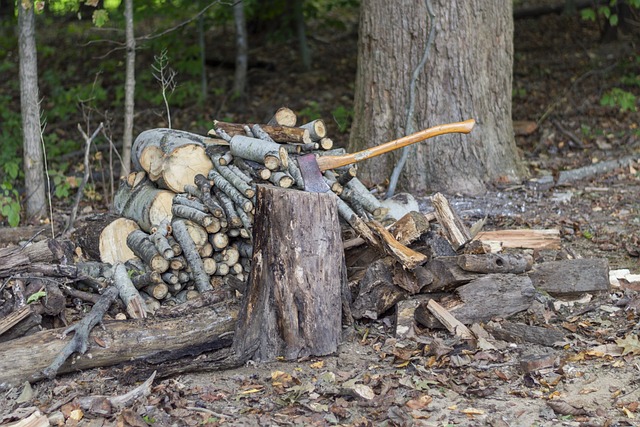Splitting wood is a timeless and essential skill for anyone who relies on firewood for heating, cooking, or even for those who enjoy the satisfaction of creating their own kindling. Whether you’re a seasoned lumberjack or a beginner looking to learn the ropes, this comprehensive guide will walk you through various techniques, tools, and tips on how to split wood effectively and safely.
Why Splitting Wood Matters
Splitting wood is not just a practical skill; it’s a fundamental one. Whether you’re preparing for winter, going camping, or just need some firewood for your backyard fire pit, knowing how to split wood can be a game-changer. Splitting wood makes it easier to ignite, burns more efficiently, and produces less smoke. It’s also a great way to get some exercise and connect with nature.
Safety Precautions
Before we delve into the techniques and tools for splitting wood, let’s start with safety. Working with sharp tools and heavy logs can be hazardous. Here are some crucial safety precautions:
- Wear Appropriate Gear: Always wear safety glasses, hearing protection, a helmet, and gloves to protect yourself from flying wood chips and other potential hazards.
- Clear the Area: Ensure that the area around you is clear of people, pets, and obstacles. A falling log can be extremely dangerous.
- Proper Stance: Stand with your feet shoulder-width apart to maintain balance. Keep your body to the side of the log you’re splitting, not in front.
- Sharp Tools: Ensure that your tools are sharp. Dull tools can cause accidents as they are more likely to bounce off the wood.
- Start Slow: If you’re a beginner, start with smaller logs and work your way up to larger ones as you gain confidence and skill.
Tools for Splitting Wood
Axes
Axes are one of the most traditional and versatile tools for splitting wood. They come in various shapes and sizes, each designed for specific tasks. Here are some common types:
- Splitting Axe: These have a heavy, wedge-shaped head that makes it easier to split logs. They often have a longer handle to provide extra leverage.
- Felling Axe: Felling axes have a more pointed blade and are used for cutting down trees. While they can be used for splitting, they are not as efficient as dedicated splitting axes.
- Maul: A maul is similar to a splitting axe, but it has a blunter head. This makes it ideal for splitting tough, knotty logs.
Wedges
Wedges are used in conjunction with a sledgehammer or maul to split logs that are too large to be split with an axe alone. They are driven into the log’s grain to force it to split along the wedge line.
Log Splitters
For those who have a large volume of wood to split regularly, a log splitter can be a real time-saver. These machines come in various sizes, from small electric models to heavy-duty hydraulic ones. They work by hydraulically pushing a log against a wedge to split it.
Techniques for Splitting Wood
Splitting Small Logs and Kindling
- Gather Your Tools: Start by ensuring you have a chopping block or a sturdy, level surface to work on. Place your log vertically on the block.
- Choose the Right Axe: For small logs and kindling, a splitting axe or maul is ideal. Hold the axe near the base of the handle with both hands.
- Aim for the Center: Focus on the center of the log, where it’s weakest. This is often where you’ll find cracks or knots that will help the log split more easily.
- The Swing: Raise the axe overhead and bring it down forcefully, aiming for the center of the log. Keep your eye on the spot you want to hit, and follow through with your swing.
- Repeat: Continue to strike the log until it splits. If it doesn’t split after a few strikes, try moving the axe slightly and hitting the log again.
- Safety Note: Be cautious when the log is about to split, as it can move unexpectedly. Keep your feet out of the path of the splitting wood.
Splitting Medium-sized Logs
- Prepare the Log: Place the log horizontally on your chopping block or a stable surface.
- Choose the Right Tool: For medium-sized logs, a splitting axe is a good choice. Hold it with both hands near the base of the handle.
- Target the Center: Similar to small logs, aim for the center of the log where it’s likely to be weaker.
- The Swing: Raise the axe overhead and bring it down with force, aiming for the center of the log. Keep your balance and maintain a steady rhythm.
- Rotate and Repeat: After each strike, rotate the log slightly and continue splitting along the grain until it splits in two.
Splitting Large Logs
Splitting large logs can be more challenging, and you may need wedges and a sledgehammer or maul for this task.
- Set Up the Log: Place the large log horizontally on your chopping block or a sturdy surface.
- Use Wedges: Start by driving a wedge into the center of the log using a sledgehammer or maul. This creates a split along the grain.
- Rotate and Repeat: As the wedge goes deeper into the log, rotate the log slightly after each strike. Continue using wedges until the log splits.
- Safety Note: Be cautious as the log splits; it can move unpredictably. Keep your feet clear of the splitting area.
Tips for Efficient Wood Splitting
Choosing the Right Wood
- Dry Wood: It’s easier to split wood that is well-seasoned and dry. Green or wet wood can be more challenging and may require more effort.
- Straight Grain: Look for logs with straight grains and fewer knots, as they are easier to split.
Stacking and Seasoning Wood
- Stack Wood Properly: When storing wood, stack it off the ground on pallets or logs to prevent moisture from seeping in from the bottom.
- Cover Wood: Use a tarp or other covering to protect your stacked wood from rain and snow.
- Allow for Air Circulation: Ensure there is good airflow between the stacked wood to aid in the drying process.
Maintaining Your Tools
- Keep Tools Sharp: Regularly sharpen your axe or maul to ensure clean cuts. A dull blade can be frustrating and less safe.
- Check Handles: Inspect the handle of your tools for cracks or damage. Replace them if necessary to prevent accidents.
- Clean and Oil: Clean your tools after use and apply a light coat of oil to prevent rust.
Staying Safe
- Know Your Limits: Don’t attempt to split wood that is too large or challenging for your skill level. Safety should always come first.
- Stay Focused: Avoid distractions when splitting wood, and keep a clear mind to maintain control over your tools.
- Work with a Buddy: If possible, have someone nearby in case of emergencies, especially when splitting large logs.
Conclusion
Splitting wood is a practical and rewarding skill that can save you money, keep you warm, and provide a sense of accomplishment. Whether you’re a seasoned pro or a beginner, following the right techniques, using the appropriate tools, and prioritizing safety will make the process efficient and enjoyable.
Remember to choose the right tool for the job, practice proper splitting techniques, and maintain your tools regularly. Additionally, ensure you have the necessary safety gear and follow safety precautions at all times. With the knowledge and skills outlined in this guide, you’ll be well-equipped to tackle any wood-splitting task that comes your way.










